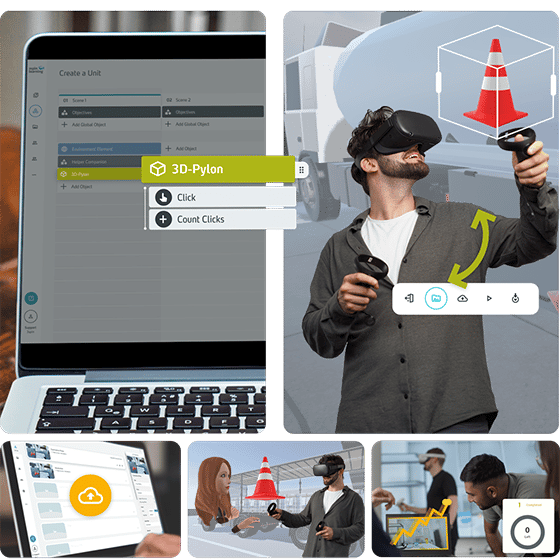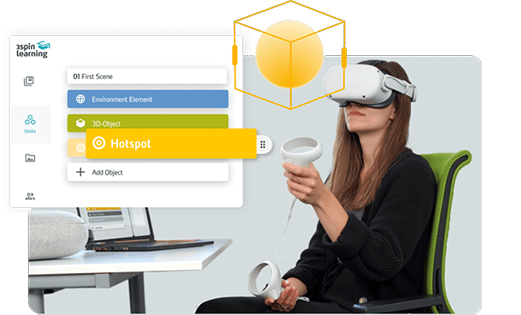VR Training: All You Need To Know About The Tools And Resources
Looking to maximize your training potential? Discover how VR training provides a safe, engaging, and effective learning experience
Discover how interactive training transforms your employee training by providing an engaging experience that improves engagement, retention and performance
Are you looking for an innovative and effective way to train your employees? Look no further than an LMS with Virtual Reality features. By immersing your employees in a realistic and engaging environment, interactive training with VR improves engagement, retention, and performance. In this article, we'll explore the meaning and method of interactive eLearning, the tools that you need to make it happen, and some examples of successful implementation.
In today's fast-paced and ever-changing world, organizations need to invest in the professional development of their employees to stay ahead of the competition. One of the most effective ways to do this is through interactive training.
Interactive eLearning engages learners by immersing them in realistic simulations and providing hands-on experiences that they can apply to real-life situations. A Learning Management System with Virtual Reality takes interactive training to the next level by immersing employees in a virtual environment that feels like the real thing.
In this article, we'll explore the meaning and method of interactive training with VR, the tools that you need to make it happen, and some examples of successful implementation.
Interactive training with VR is a cutting-edge approach to employee development that enables learners to experience realistic simulations in a virtual environment. It is a powerful tool for improving engagement and retention by immersing employees in an environment that feels like the real thing.
The method involves using VR technology to create simulations that employees can interact with, allowing them to practice skills and behaviors in a safe and controlled environment. By doing so, employees can develop the skills and knowledge that they need to succeed in their roles and increase their performance.
Virtual Reality technology has opened up new possibilities for interactive training, providing learners with an immersive and engaging experience that simulates real-world scenarios. Here are some of the different interactive eLearning methods that can be used with VR:
Simulation-based learning allows learners to practice skills and behaviors in a safe and controlled environment. With VR technology, simulations can be created that mimic real-life situations, such as emergency response, customer service, or sales scenarios. This approach allows learners to develop their skills in a realistic setting, without the risk of mistakes or harm.
Gamification is the use of game-like elements in non-game contexts, such as training or education. With VR technology, gamification can be taken to the next level by providing learners with a fully immersive and interactive experience. For example, learners can participate in role-playing scenarios, where they must make decisions that impact the outcome of the game.
Scenario-based learning involves presenting learners with real-life scenarios and allowing them to make decisions based on the information provided. With VR technology, scenarios can be created that are interactive and allow learners to explore different outcomes based on their decisions. This approach can help learners develop critical thinking and problem-solving skills.
Immersive learning involves creating an environment that fully engages learners in the learning experience. With VR technology, learners can be transported to different environments, such as a factory floor or a customer service desk, and interact with the environment in a realistic way. This approach can help learners develop situational awareness and empathy.
On-the-job training involves providing learners with hands-on experience in a real-world setting. With VR technology, on-the-job training can be simulated in a safe and controlled environment. For example, a new employee can be trained on a machine or process before working with it in real life, reducing the risk of accidents or mistakes.
In conclusion, training in the virtual classroom provides a range of different interactive eLearning methods that can be used to improve engagement, retention, and performance. Whether it is simulation-based learning, gamification, scenario-based learning, immersive learning, or on-the-job training, the possibilities are endless with VR technology. With the right tools and resources, interactive training with VR can revolutionize the way we learn and grow in the workplace.

To implement interactive training with VR, you will need a few essential tools. The first is an LMS with the benefit of integrated VR technology. Then you will need VR hardware and software to create VR simulations, such as Unity or Unreal Engine.
An LMS is a software application used to create, manage, and deliver e-learning content. Implementing VR into your LMS with VR capabilities enables organizations to create and manage VR training content, track learner progress, and assess performance.
VR hardware includes VR headsets, controllers, and other accessories that are needed to deliver an immersive VR experience. There are various types of VR hardware available, ranging from standalone VR headsets to high-end VR setups that require a powerful PC.
VR software is used to create virtual environments and simulations. There are many different VR software options available, including Unity, Unreal Engine, and Vizible. These software tools allow organizations to create realistic simulations that mimic real-world scenarios.
Content authoring tools are used to create e-learning content, including VR training modules. These tools enable organizations to create interactive and engaging content that can be delivered through an LMS. Examples of content authoring tools include Articulate Storyline and Adobe Captivate.
3D modeling tools are used to create 3D models and environments that can be used in VR simulations. These tools allow organizations to create realistic and detailed environments that learners can interact with. Examples of 3D modeling tools include Blender and SketchUp.
Cloud-based Solutions
Cloud-based solutions provide a way for learners to access VR training content from anywhere, at any time. These solutions allow learners to access VR training modules through an LMS or web browser, eliminating the need for dedicated hardware and software.

Interactive training with VR has been successfully implemented in a variety of industries, from medicine to manufacturing. One example is the use of VR in healthcare to train medical professionals in surgical procedures. By using VR simulations, medical professionals can practice complex surgeries in a safe and controlled environment, reducing the risk of mistakes in real-life surgeries.
Another example is the use of VR in manufacturing to train employees on complex machinery and processes. By using VR simulations, employees can learn how to operate machinery in a safe and controlled environment, reducing the risk of accidents and injuries.
Let’s have a closer look at successful implementation of VR examples in the workplace:
Safety training is an essential part of employee training, particularly in industries such as manufacturing and construction. With 3spin learning, educators can create realistic simulations of hazardous scenarios that employees may encounter in their work. These simulations allow employees to practice their safety procedures in a safe and controlled environment, reducing the risk of accidents and injuries.
Soft skills, such as customer service and leadership, are essential for employee success in many industries. With 3spin learning, educators can create simulations of real-life scenarios that require employees to use their soft skills to navigate the situation. These simulations allow employees to practice their soft skills in a realistic and engaging environment, improving their performance in real-life situations.
Product training is essential for employees in industries such as retail and hospitality. With 3spin Learning, educators can create simulations of products that employees need to learn about. These simulations provide employees with a realistic and engaging environment to learn about the product's features, benefits, and use cases.
Language training is essential for employees in industries that require communication with international clients or customers. With 3spin learning, educators can create simulations of real-life situations that require employees to use their language skills to communicate effectively. These simulations provide employees with a safe and controlled environment to practice their language skills, improving their ability to communicate with international clients and customers.
Onboarding training is essential for new employees to get up to speed with their job duties and company culture. With 3spin learning, educators can create simulations of the company's processes and procedures, providing new employees with a realistic and engaging environment to learn about their job responsibilities and company culture.
In conclusion, 3spin learning provides educators and trainers with a powerful tool to create immersive and engaging VR training experiences. These experiences can be applied to various industries and training topics, including safety training, soft skills training, product training, language training, and onboarding training. By providing learners with a realistic and engaging environment to practice their skills and behaviors, VR training using 3spin learning can improve engagement, retention, and performance.
Interactive eLearning with VR is a powerful tool for employee development that enables learners to experience realistic simulations in a virtual environment. By immersing employees in a realistic environment, interactive training with VR improves engagement, retention, and performance.
To implement interactive training with VR, you will need an LMS with VR capabilities, VR hardware, and software that can create VR simulations. Successful implementation has been seen in various industries, from healthcare to manufacturing. Overall, interactive training with VR is an innovative approach to employee development that is changing the way we learn and grow in the workplace.

Looking to maximize your training potential? Discover how VR training provides a safe, engaging, and effective learning experience
Discover the best soft skills courses and further training. Train key skills for work and everyday life now.
Discover the top 10 soft skills in professional life with practical examples and modern training methods such as AI-supported learning with 3spin...
Stay up to date on new insights in VR / AR learning with AI and build or improve your knowledge within the technology.